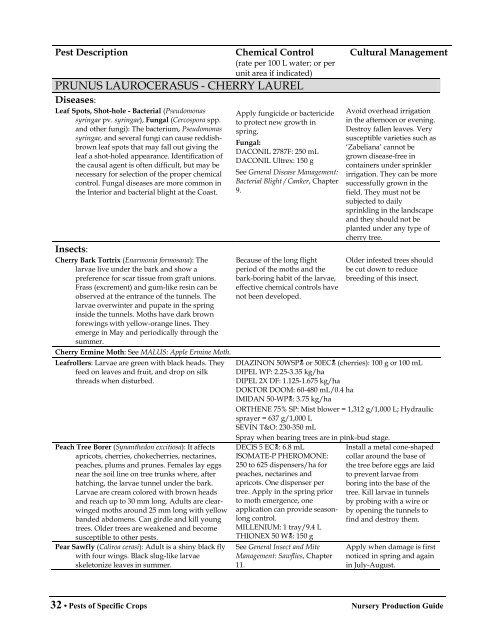You also want an ePaper? Increase the reach of your titles
YUMPU automatically turns print PDFs into web optimized ePapers that Google loves.
Pest Description<br />
Chemical Control<br />
(rate per 100 L water; or per<br />
unit area if indicated)<br />
PRUNUS LAUROCERASUS - CHERRY LAUREL<br />
Diseases:<br />
Leaf Spots, Shot-hole - Bacterial (Pseudomonas<br />
syringae pv. syringae), Fungal (Cercospora spp.<br />
and other fungi): The bacterium, Pseudomonas<br />
syringae, and several fungi can cause reddishbrown<br />
leaf spots that may fall out giving the<br />
leaf a shot-holed appearance. Identification <strong>of</strong><br />
the causal agent is <strong>of</strong>ten difficult, but may be<br />
necessary for selection <strong>of</strong> the proper chemical<br />
control. Fungal diseases are more common in<br />
the Interior and bacterial blight at the Coast.<br />
Insects:<br />
Cherry Bark Tortrix (Enarmonia formosana): The<br />
larvae live under the bark and show a<br />
preference for scar tissue from graft unions.<br />
Frass (excrement) and gum-like resin can be<br />
observed at the entrance <strong>of</strong> the tunnels. The<br />
larvae overwinter and pupate in the spring<br />
inside the tunnels. Moths have dark brown<br />
forewings with yellow-orange lines. They<br />
emerge in May and periodically through the<br />
summer.<br />
Cherry Ermine Moth: See MALUS: Apple Ermine Moth.<br />
Leafrollers: Larvae are green with black heads. They<br />
feed on leaves and fruit, and drop on silk<br />
threads when disturbed.<br />
Peach Tree Borer (Synanthedon excitiosa): It affects<br />
apricots, cherries, chokecherries, nectarines,<br />
peaches, plums and prunes. Females lay eggs<br />
near the soil line on tree trunks where, after<br />
hatching, the larvae tunnel under the bark.<br />
Larvae are cream colored with brown heads<br />
and reach up to 30 mm long. Adults are clearwinged<br />
moths around 25 mm long with yellow<br />
banded abdomens. Can girdle and kill young<br />
trees. Older trees are weakened and become<br />
susceptible to other pests.<br />
Pear Sawfly (Caliroa cerasi): Adult is a shiny black fly<br />
with four wings. Black slug-like larvae<br />
skeletonize leaves in summer.<br />
Apply fungicide or bactericide<br />
to protect new growth in<br />
spring.<br />
Fungal:<br />
DACONIL 2787F: 250 mL<br />
DACONIL Ultrex: 150 g<br />
See General Disease Management:<br />
Bacterial Blight / Canker, Chapter<br />
9.<br />
Because <strong>of</strong> the long flight<br />
period <strong>of</strong> the moths and the<br />
bark-boring habit <strong>of</strong> the larvae,<br />
effective chemical controls have<br />
not been developed.<br />
Cultural Management<br />
Avoid overhead irrigation<br />
in the afternoon or evening.<br />
Destroy fallen leaves. Very<br />
susceptible varieties such as<br />
‘Zabeliana’ cannot be<br />
grown disease-free in<br />
containers under sprinkler<br />
irrigation. They can be more<br />
successfully grown in the<br />
field. They must not be<br />
subjected to daily<br />
sprinkling in the landscape<br />
and they should not be<br />
planted under any type <strong>of</strong><br />
cherry tree.<br />
Older infested trees should<br />
be cut down to reduce<br />
breeding <strong>of</strong> this insect.<br />
DIAZINON 50WSP or 50EC (cherries): 100 g or 100 mL<br />
DIPEL WP: 2.25-3.35 kg/ha<br />
DIPEL 2X DF: 1.125-1.675 kg/ha<br />
DOKTOR DOOM: 60-480 mL/0.4 ha<br />
IMIDAN 50-WP: 3.75 kg/ha<br />
ORTHENE 75% SP: Mist blower = 1,312 g/1,000 L; Hydraulic<br />
sprayer = 637 g/1,000 L<br />
SEVIN T&O: 230-350 mL<br />
Spray when bearing trees are in pink-bud stage.<br />
DECIS 5 EC: 6.8 mL<br />
ISOMATE-P PHEROMONE:<br />
250 to 625 dispensers/ha for<br />
peaches, nectarines and<br />
apricots. One dispenser per<br />
tree. Apply in the spring prior<br />
to moth emergence, one<br />
application can provide seasonlong<br />
control.<br />
MILLENIUM: 1 tray/9.4 L<br />
THIONEX 50 W: 150 g<br />
See General Insect and Mite<br />
Management: Sawflies, Chapter<br />
11.<br />
Install a metal cone-shaped<br />
collar around the base <strong>of</strong><br />
the tree before eggs are laid<br />
to prevent larvae from<br />
boring into the base <strong>of</strong> the<br />
tree. Kill larvae in tunnels<br />
by probing with a wire or<br />
by opening the tunnels to<br />
find and destroy them.<br />
Apply when damage is first<br />
noticed in spring and again<br />
in July-August.<br />
32 • <strong>Pests</strong> <strong>of</strong> <strong>Specific</strong> <strong>Crops</strong> Nursery Production Guide
















